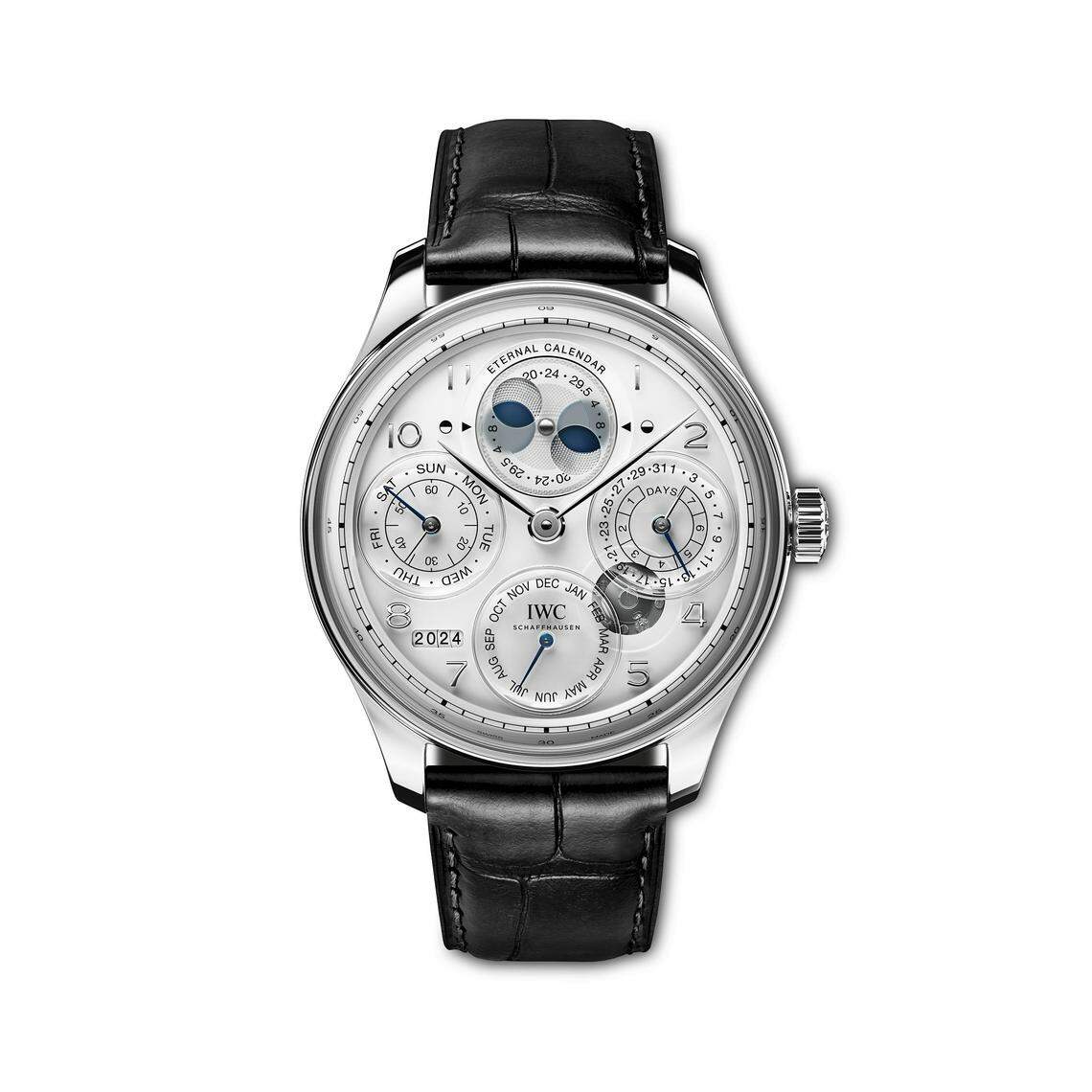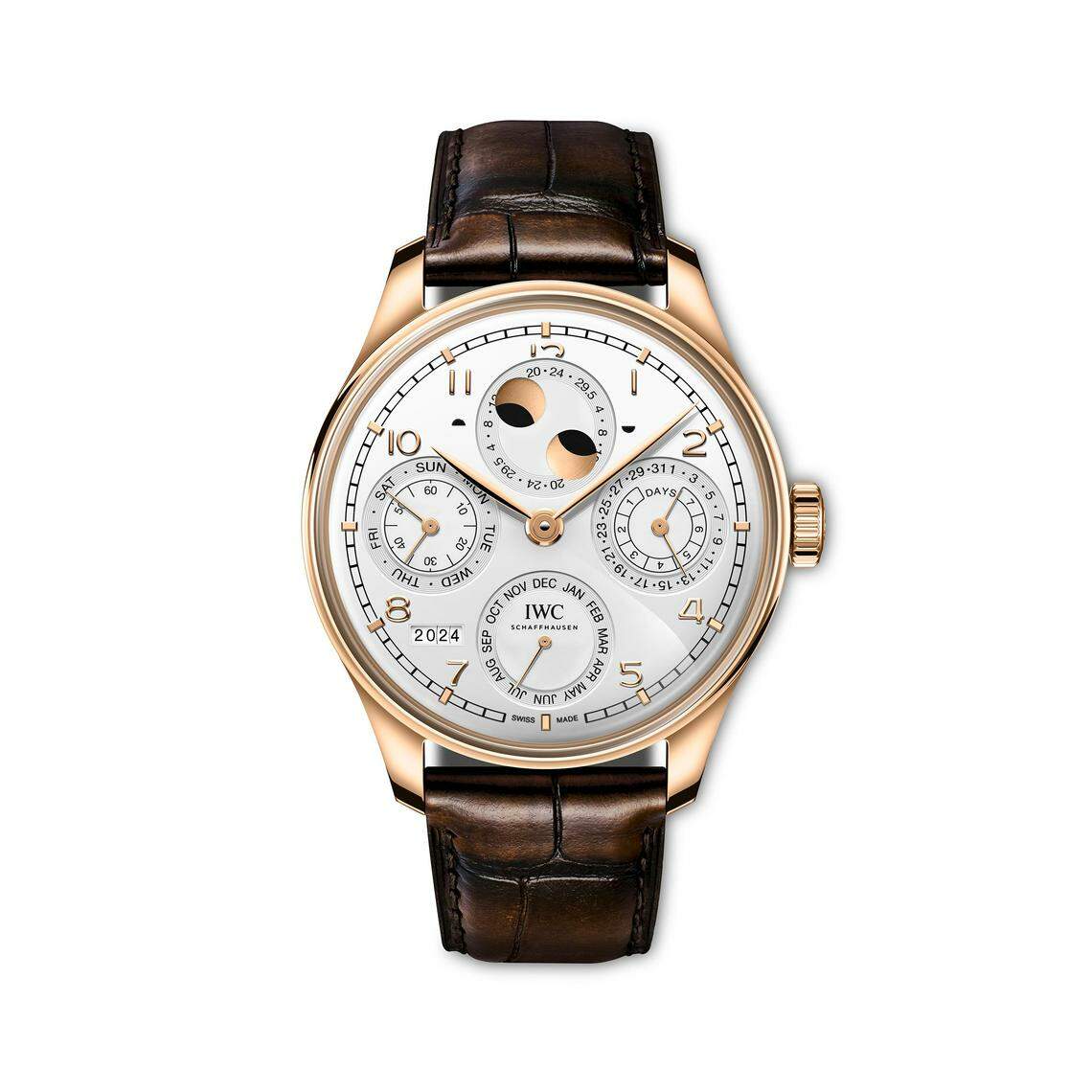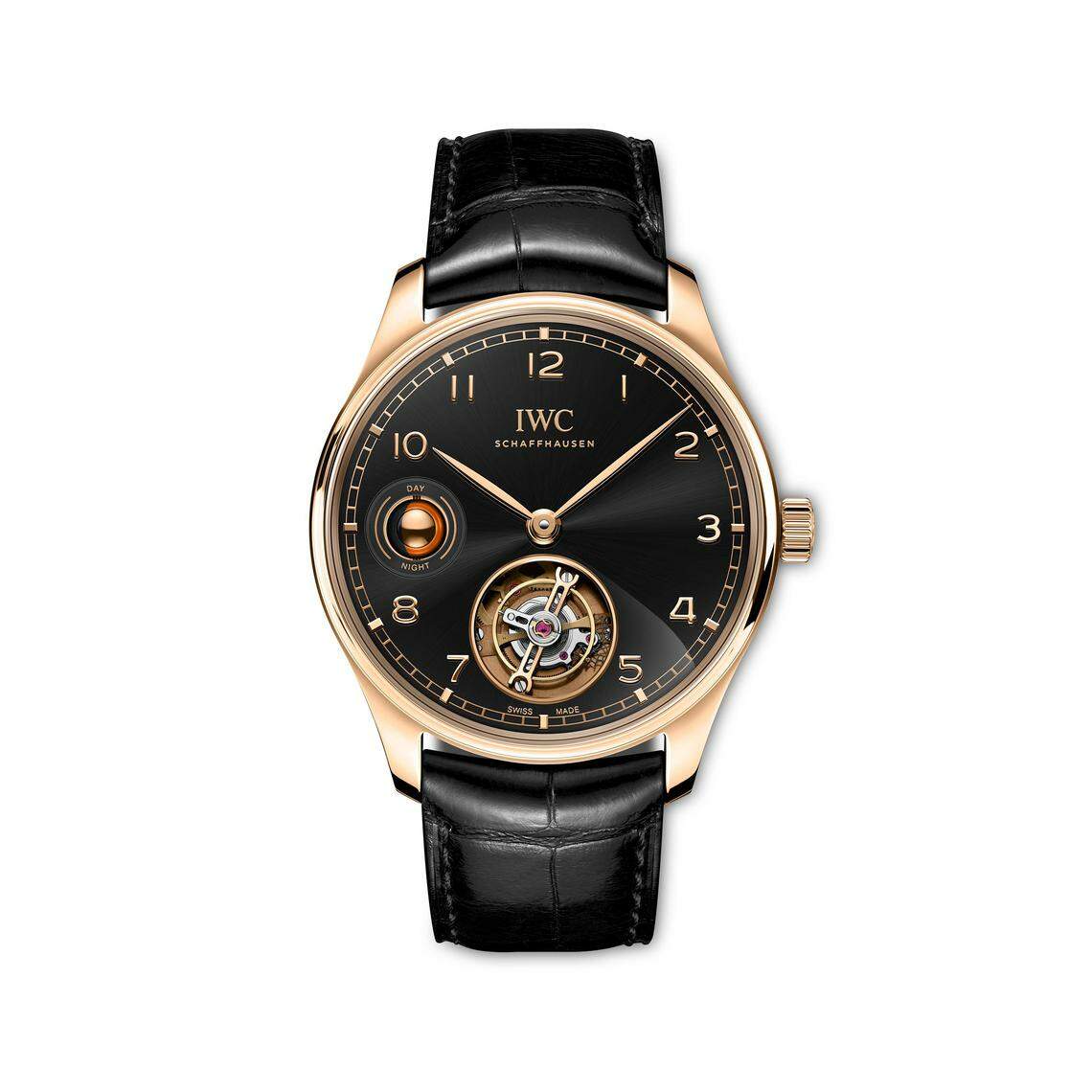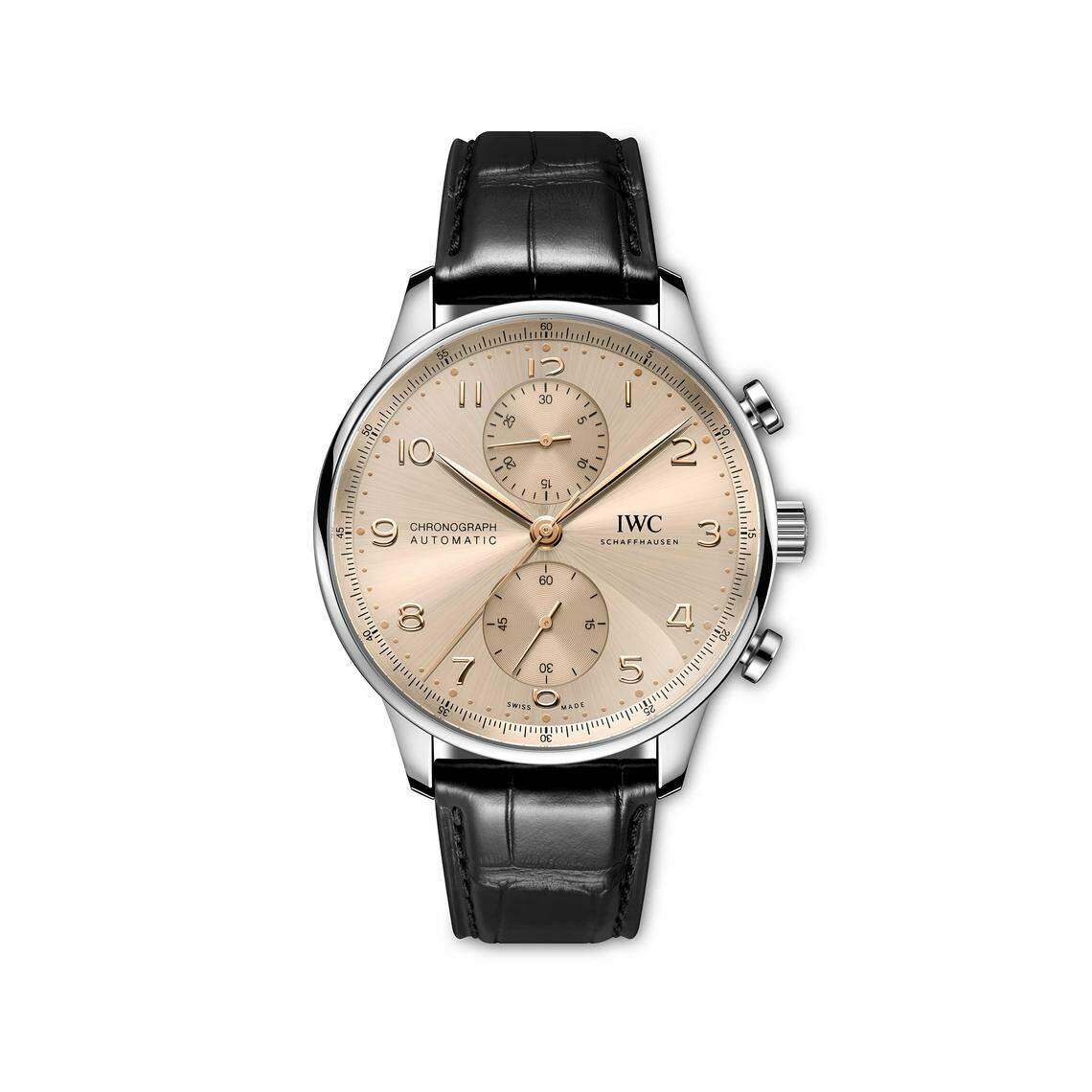IWC unveils a breakthrough calendar watch that goes beyond perpetual
The brand’s Watches & Wonders 2024 novelties take its Portugieser collection to the next level

THE NOVELTY TIMEPIECES SHOWCASED BY IWC Schaffhausen at Watches & Wonders 2024 were large. Arabic numerals and slim, leaf-like hands indicated the time on dials ringed by a railway-track style chapter. All carried the hallmarks of the Portugieser collection, which took the spotlight this year at the IWC booth.
The star was the Portugieser Eternal Calendar, which is a breakthrough in the development of perpetual calendars. Four new dial colours were also rolled out – Horizon Blue, Dune, Obsidian and Silver Moon.
The new watches all have intricately crafted dials, finished with 15 layers of transparent lacquer and powered by IWC-made movements.
Portugieser Eternal Calendar

Contrary to what some may expect, the perpetual calendar watch has not turned back the clock in IWC’s new “eternal” calendar timepiece. But rather than being a step backwards, the Portugieser Eternal Calendar actually brings the perpetual calendar more up to date.
A key feature of the traditional perpetual calendar watch is its automatic adjustment for leap years. According to the Gregorian calendar, the year is split into 12 months with 28, 30 or 31 days; in a leap year it’s 29 and not the common 28 days in February. A normal calendar timepiece, like the annual calendar, tracks the calendar faithfully but in a leap year, a manual adjustment has to be made to add the extra day to February. This manual intervention is not required in the perpetual calendar.
However, the perpetual calendar is only programmed to track the leap year over a four-year cycle, automatically tagging a leap day at end-February on the fourth year. Over a 400-year period, the fourth year is not a leap year for a centurial year. In the longer time frame only those centurial years divisible by 400, instead of four, are leap years. So 2000 and 2400 are leap years while 2100, 2200 and 2300 are not. This means the perpetual calendar needs three corrections over 400 years.
A NEWSLETTER FOR YOU

Lifestyle
Our picks of the latest dining, travel and leisure options to treat yourself.
The eternal calendar, which is built on IWC’s almost four decades of expertise with the perpetual calendar, is not only programmed for the four-year cycle, including the leap day in February, but is also equipped with a 400-year corrector that skips the three centurial years for the period that would have been wrongly tracked as leap years in a perpetual calendar.
In this more up-to-date calendar timepiece, the moon-phase is also more precisely displayed on the dial, framed in a large 44.4 mm wide platinum case. The display deviates from the moon’s orbit only by one day after 45 million years, against 577.5 years in the Portugieser Perpetual Calendar – thanks to a new reduction gear train using three intermediate wheels.
Nestling beneath the dial, which is protected by an elaborately machined and polished box-glass, is the newly in-house developed 52640 calibre. The automatic movement is packed with seven days’ power reserve when fully wound. Incidentally, the movement is fitted with a highly efficient Pellaton winding system.
Portugieser Perpetual Calendar 44

The eternal calendar has not spelt doom for IWC’s perpetual calendar model, first rolled out in 1985 in its Da Vinci line. The complication remains the brand’s pride and joy. After all, it got IWC started on building and achieving its all-round expertise in mechanical calendar complications today. And the Portugieser Perpetual Calendar, launched in 2003, has grown into a key pillar of the Portugieser collection.
Despite the flaw in not being in sync with the actual solar year, improvements have been made over the years. Later IWC perpetual calendars have a more accurate moon-phase display, for instance. In this latest model, the case is totally reworked and refined with a much slender case ring. So despite its 44.4 mm size, the watch is lighter and elegant.�
The new Portugieser Calendar 44 comes in four versions: two in 18-ct white gold with Horizon Blue and Dune dials; and two in 18-ct 5N Armor Gold®️ with an Obsidian black or a Silver Moon dial. The Armor Gold is deemed harder and more wear-resistant than the conventional 5N gold. The in-house 52616 calibre self-winding movement which powers the watch is fitted with an improved escapement that provides better protection against magnetic fields.
Portugieser Hand-Wound Tourbillon

One of the most sophisticated complications in watchmaking, this flying minute tourbillon is a delicate mechanism fine-tuned and assembled by IWC’s most experienced master watchmakers. The most captivating feature of this gravity-defying timepiece is, of course, the tourbillon cage which stands out on the dial at 6 o’clock. It houses the timekeeping device, the balance wheel; and the escapement or pallet lever which feeds the balance spring energy from the mainspring.
The tiny cage whirls around its axis once every minute, which is why the watch is called a flying minute tourbillon. Its constant rotation minimises the influence of gravity on the watch’s oscillating system, thereby increasing its accuracy. As the tourbillon cage stops and accelerates several times per second, its total weight must be kept as low as possible. So while IWC has taken 56 parts to stitch together the mechanism, which is set against an Obsidian lacquered dial framed in a 42.4 mm 18-ct Armor Gold® case, it weighs only 0.675 gram in total.
Another highlight of the Portugieser Hand-Wound Tourbillon is the day and night 24-hour display. It comes in the shape of a small globe which has a dark and a bright side and rotates around its axis once every 24 hours, indicating whether it’s night or day. The globe is visible from the front and back of the watch. The watch is powered by an in-house manual winding movement with 84 hours’ power reserve.
Portugieser Chronograph

First unveiled in 1988, this stopwatch on the wrist has brought a touch of sporty elegance to the Portugieser line. While the sub-dials of most chronographs are positioned horizontally across the dial, on many IWC models they are aligned vertically down the middle of the dial.
Another distinguishing feature of the new 41 mm IWC chronograph is the inner flange printed with a quarter-second scale in the dial, which allows for high-precision stop-time readings.
Running on an automatic movement with 46 hours’ power reserve, the Portugieser Chronograph has several versions: one with a Horizon Blue dial encased in 18-ct white gold and a matching gradient light-blue calfskin strap; another with an Obsidian black dial, an 18-ct 5N gold case and black alligator leather strap; and still another with a Dune dial, a stainless steel case and a black alligator strap.
Portugieser Automatic

This dress watch which never grows old is now housed in a new 40 mm and 42 mm case with a thinner side profile, making it even more elegant and refined. The double box-glass sapphire crystal that shields the front of the timepieces also offers a clearer view of the dial, which is distinguished by a balanced design and the power reserve indicator at 3 o’clock as well as small seconds at 9 o’clock.
The sapphire crystal at the back of the timepieces showcases an in-house self-winding movement which has been upgraded to provide better protection against magnetic fields.
The Portugieser Automatic 42, which still retains the good looks of the original launched in 2000, is now also encased in 18-ct white gold and 18-ct 5N gold – the former framing a Horizon Blue dial and worn with a gradient light-blue calfskin strap; the latter an Obsidian black dial and worn with black alligator strap.
Buyers who prefer the steel model have a choice of three colours for the dial – Dune, Silver Moon and Blue – paired respectively with a black leather strap, blue alligator strap and steel bracelet.
The compact Portugieser Automatic 40, first rolled out in 2020 and is in direct lineage to the first Portugieser introduced in 1939, now also comes in a white gold case framing a Horizon Blue dial matched with a gradient light-blue calfskin strap; and an 18-ct 5N gold case with an Obsidian black dial and black alligator strap.
BT is now on Telegram!
For daily updates on weekdays and specially selected content for the weekend. Subscribe to t.me/BizTimes
BT Luxe
Private helicopter wine tours, coastal golf and indulgent spas: Luxe escapes to elevate your next vacation
Charmain Kwee: Steering a car empire at 27
Vacheron Constantin breaks record for most complicated watch
From safari bush retreats to coastal havens: These Top End stays offer the perfect blend of wilderness and luxury
Lee Hui Li: Empowering women, embracing change
Tan Min Lan: Deftly navigating the complexities of leadership
